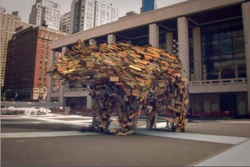“I AM” Interview

Vivian Rosenthal
Sebastien Agneessens
I find the title I AM to be interesting because the poetry that is spoken in the piece is mainly about the future or the past, but not about the present. How would you describe your choice of I AM for the title for this piece?
VIVIAN:
The title comes from the animals’ declaration of who they are. Each animal says, “I AM the elephant” and “I AM the horse” and it’s through language that they are reinforcing their physicality and their place in the world. And the irony, of course, is that animals don’t have access to our language, they have their own languages, but we privilege ours. And so with this piece, the idea was that by giving them access to language, it was giving them agency, giving them power, giving them the ability to be heard. And so the title I AM I chose really as a way to underscore the importance of our understanding of the self. And by expressing the self, I think people can understand how to relate not just to animals, but to the planet at large, and to see it as a reflection of themselves and therefore hopefully care more about its future and our future collectively.
Q:
I feel that in this piece there is a juxtaposition of a known city, which is New York City, with some kind of generic urban landscape without any people in it. It’s very desolate, and there is some kind of archeological relic that is being built in this architectural landscape. And this relic, even though it’s being built in front of your eyes, seems very old. It seems like a ruin of some sort. Why did you choose to depict the animals in such a fragile and man-made state, almost like a vestige?
V:
I love that question, because I think it’s so insightful in terms of the thinking that went into the piece. Essentially the reason the animals have this archaic feeling is because that’s how they are quickly becoming, they are becoming relics. So instead of giving them a more sleek form or language, we chose to have them made out of detritus, just out of found wood. And the reason for that was that it feels that they are becoming these vestiges of trash essentially, because that’s how we are treating them. By treating the planet and our environment that way, we are essentially doing the same to these creatures. They are becoming almost like walking ghosts that are just drifting through a manufactured landscape.
Q
Now, the only animal that is free is the one that disappears. Which means that it’s the one that doesn’t belong to the human world anymore, or the manufactured landscape as you call it. Do you think that this piece is mainly about the relationship between nature and culture? Or mankind? Or do you think it’s a piece about the place of animals in the environment?
V:
Well, hopefully it can have a personal interpretation for each viewer. Since I can’t speak for everyone, and only myself, I think for me, yes, it’s very much about the erasure of history as we move forward. And I think as animals and human cultures become extinct, they are only going to live on through our memory, and obviously through images and film. But really, I think we almost need to be forced to see them in a new light, made up of wood, to recognize their fragile state. That’s a big part of why they keep breaking and collapsing, it’s almost like these are their last words, their last breath, before they are destroyed, before they are made extinct.
Q
Why the choice of these 4 particular animals- the elephant, the horse, the bear and the bird?
V:
It’s not really about the specificity of these particular animals, it could have been any type of animal, it’s more about capturing a moment in time. The elephant, the horse, the bear- those three were chosen for their size and their feeling of power. The bird, and I think you touched on this in one of your other questions, the bird was really speaking to the idea of hope. So the other three kind of have the sense of defeat and nostalgia, and a sense of having given up and lost. Whereas the bird, because it can fly, symbolically to me still held hope, the hope that somehow it could escape to a better landscape or a better point in history. Whether or not it can is a whole other question, but this was really talking about the symbolic nature of the bird.
Q
But from what I understand in this piece, is the hope for survival of the bird to actually escape human civilization?
V:
Yeah, I guess sadly it is, at least metaphorically. I’d like to think that maybe they’ll be a shift, and instead of damaging the environment and the planet, we’ll start to help it. But I think we are a long way off. There is a lot of damage that we would have to undo before we could get back to a place of equilibrium, and then actually do something with a positive effect. So, yes, maybe this escape fantasy is stronger, even if it’s not necessarily more viable than the actual solution.
Q
Now on a more visual and cinematic level, the way the animals are being built and unbuilt is very magical because it starts with the top, instead of starting with the bottom. Why this decision?
V:
I like that you feel like it’s magical, because there is an element of magic and dreaming in this piece. I mean, obviously, we are giving a voice to the animals, and they can’t normally speak, and in that same way we wanted to show that not only are they interrelated but we are too, with them, and with the world around us. And so in the deconstruction and the reconstruction of them, it was the idea that the weight of one collapses onto itself, it literally can’t support itself anymore. The planet is not self-sustaining, it too could collapse. The declaration of I AM is their last breathe, and hearing that basically gives rise to the next utterance, and so on and so forth, until they have basically lost all ability to exist.
S:
How do you see the future of humanity as it relates to technology and its environment? What is a new day for you?
V:
Well, I would like to say that I believe in an enlightened future, but I’m not convinced that’s the case. I mean, it will be enlightened in some ways, certainly as it relates to technology, but I think in its wake there is going to be a lot of loss and a lot of destruction. And that is somewhat consistent with the cycles of civilization that we have seen to date. Every great civilization is replaced by the next great civilization. This project speaks to those losses. We must not become so seduced by technology that we forget the natural world around us.
November 2, 2009








